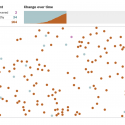With new updates developing by the hour amidst the evolving COVID-19 pandemic, trying to grapple at the most relevant information can be overwhelming. Data visualization has helped to synthesize this complex phenomena and shape the timeline of the Coronavirus pandemic that has drastically changed how we go about our daily lives. While commonly used to communicate data to the general population, visualization is now having quite a real-world impact in the face of this crisis.
Having access to diverse sets of visualizations allows the public to obtain information relevant to their situation, whether they are a community member or a political leader. “In general we react more strongly to data that feels close to us,” said Catherine Plaisant, Senior Research Scientist at the University of Maryland Institute for Advanced Computer Studies. “[The American public] may dismiss stories of China and Italy, and only react when shown data about their own hospitals being overwhelmed.”
In particular, data visualization charts have been central in illustrating the concept of “flattening the curve” so that the public can better understand the need to practice social distancing so that the spread of the virus is slowed.
Maps have also been shown to resonate as a visual representation of data, because people like to see where things are happening. However, maps don’t always convey the entire story. “Namely, it’s difficult for a map to convey both time and magnitude, both of which are crucial for understanding a pandemic,” said Brian Ondov, researcher and Ph.D. student at UMD’s Department of Computer Science. Additionally, “when you see an area on a map where the confirmed case number is low, you don’t really know if that is because there aren’t many cases or just not much testing.”
Researchers and faculty at the University of Maryland Human-Computer Interaction Lab (HCIL) began compiling a central collection of data visualization charts, videos, and other resources covering COVID-19. Below are four of the most impactful data visualizations gathered by the HCIL team that have aided in illustrating the emerging COVID-19 cases and where the cases are located, the reasons behind why the virus spread its way across the world in a matter of days, and projections based on the current situation.

